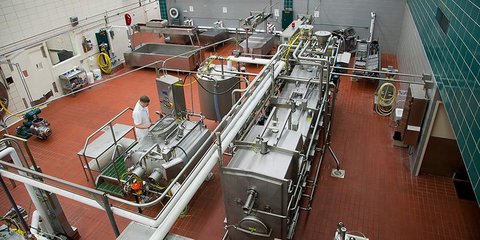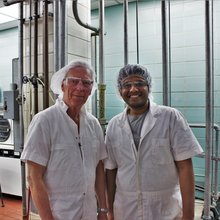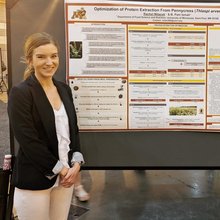Wednesday, October 13th, 2021
North Star Ballroom, St. Paul Student Center, St. Paul Campus
Join the Department of Food Science and Nutrition in our discussion and exploration of Transferable Research in modern science. Learn about current research initiatives within the Department, discuss the benefits of transferable skills and interdisciplinary competencies, and network with faculty, students, and industry professionals. We're excited to see you there!
Agenda
2:30 - 3:30 FScN Advisory Council Quarterly Meeting (Closed to Public)
3:30 - 4:00 Poster Session
4:00 - 5:15 Food Science and Nutrition Research Presentations
- Topics will include sensory aspects of cheese, developing transferable skills using project-based learning, advances in mineral metabolism, and bacteriophage use in food protection.
5:15 - 5:45 Poster Session & Refreshments
5:45 - 6:30 Keynote Address: “Food Science & Nutrition Research – What’s the End Game?”
- Julie Simonson, Vice-President Technology Development - Schwan's Company
6:30 - 7:00 Social
Julie Simonson, PhD
What is Transferable Research?
Transferable Research is the idea that many scientific methods, techniques, and pursuits are applicable across various, seemingly disparate, disciplines. Food and nutrition are an excellent example of when transferable and systems thinking are vital to scientific progress. Whether the work being done is in physics, chemistry, biology, medicine, or community health, we in FScN apply our knowledge and efforts toward the advancement of food systems, health, and society. In this Showcase, we are celebrating how the work we do in our Department is contributing to the development of transferable skills and competencies that can be utilized in a vast array of interconnected fields.
Meet our Keynote Speaker: Dr. Julie Simonson
DR. JULIE SIMONSON
VICE PRESIDENT – TECHNOLOGY DEVELOPMENT
SCHWAN’S COMPANY
Julie is Vice-President of Technology Development at Schwan’s Company, where she is responsible for an R&D team that identifies and advances research programs and open innovation initiatives to support the company’s innovation strategy. Schwan’s Company, an affiliate of CJ ChielJedang, is a leading U.S. manufacturer and marketer of quality foods offered through retail-grocery and food-service channels. Its many popular brands include Red Baron®, Tony’s®, Big Daddy’s®, Villa Prima®, and Freschetta® pizza, Mrs. Smith’s® and Edwards® desserts, and Bibigo, Pagoda®, Minh®, Kahiki® and Annie Chun's® Asian style foods.
Julie was influential in the original organizational design of the Plant Protein Innovation Center (PPIC) at the University of Minnesota and has been a member of the PPIC’s Executive Board since its inception in 2019.
Prior to joining Schwan’s nine years ago, Julie worked at the Campbell Soup Company for four years as Vice President R&D and at Kraft Foods (in US and Europe) for 17 years in numerous R&D roles and categories.
Julie earned her Ph.D. in Food Science from the University of Minnesota – Twin Cities and her B.S. in Food Science from Iowa State University.
Tour our Facilities and Lab Groups
Joseph J. Warthesen Food Processing Center (Pilot Plant)
The pilot plant provides the University of Minnesota with excellent food product research and teaching facilities. The primary goal of the center is to provide a teaching and research infrastructure for the department, and to provide our students with the ability to work and conduct research in an operating production facility.
View the Facility Visit Their Page
Bowden Lab
The lab of Dr. Steven Bowden is a food microbiology lab studying Salmonella. Our work involves identifying and characterizing Salmonella-infecting bacteriophages and understanding bacteriophage resistance, both from the perspective of food safety. We are also studying control measures for Salmonella contamination of alfalfa.
Tour his Research Lab Learn more about Dr. Bowden
Flavor Research Lab and Encapsulation Center
Led by Dr. Gary Reineccius, FSCN has long been renowned for our excellence in flavor research. He is an expert in needs and trends of the industry, which have evolved over time, as well as the encapsulation of food ingredients, emulsions, and flavoromics (chemometrics as applied to flavor chemistry).
The Encapsulation Research and Education Center addresses the need for important research into the functionalization of ingredients and industry trends. For example, the need for clean labels is driving finding natural ingredients or alternative processing techniques to replace traditional food additives. These natural materials tend to be much less stable than the artificial counterparts thereby benefitting from encapsulation. We also find new food components/isolates coming onto the market. Some of these materials offer unique properties for use as encapsulation materials. Overall, there is a need to find new materials or processes to offer better protect and controlled delivery in the food/nutrition area.
Tour the Research Lab Learn more about Dr. Reineccius
Food Engineering Research Lab
The FSCN Food Engineering Lab is led by Dr. Kumar Mallikarjunan. He specializes in food process engineering, process modeling and optimization, non-contact non-destructive sensing, extraction of phytochemicals, electronic nose, and Fourier transform infrared spectroscopy.
Tour the Research Lab Learn more about Kumar
Protein Research Lab and PPIC
The FSCN Protein Research Lab and the CFANS Plant Protein Innovation Center are directed by Dr. Pam Ismail, our resident expert in protein ingredient chemistry, functionality of plant protein ingredients, food analytical chemistry, and the composition and functionality of sustainable crops.
The Plant Protein Innovation Center is an interdisciplinary research center dedicated to studying plant and alternative proteins. The PPIC is proud to have 19 members at both the Partner and Associate level, which span the supply chain. Out of these 19 members, 14 were founding members who joined the Center within just over a year of its inauguration.
Visit the PPIC Website Learn More About Dr. Ismail
Watch an Intro to Protein Research at FScN
View and learn about more of our research groups
Nutrition Research Posters and Presentations
Kendal Schmitz *Poster Prize Winner and Oral Presenter*
Program & Advisor: Nutrition PhD, Kathleen Hill Gallant
Title: Effects of Low and High Dietary Phosphorus and Acute High Dietary Phosphorus on Intestinal Phosphate Transporters and Biochemistries in Nephrectomized Male Rats
Abstract: Dietary phosphorus(P) restriction and P binders are commonly used in patients with chronic kidney disease(CKD) to reduce intestinal P absorption to slow development of CKD-mineral and bone disorder. We previously reported that in vivo P absorption efficiency is lower when an acute high P load is given following a week of low P diet in male rats with and without CKD(ASBMR 2020 #742). Here, we report further data from this study on the effects of dietary P level and acute high P on plasma P, phosphaturic hormones, and intestinal P transporter expression.
Male CD(SD) rats with 5/6 nephrectomy (n=36) or sham (n=36) were block randomized to 1 of 3 diets: low P(LP, 0.1%), high P(HP, 1.2%), or low P followed by acute high P(LPHP, 0.1% then 1.2%)(n=12/group) and were fed for 4h/d for 7d. LPHP rats were fed the LP diet on days 1-6 and the HP diet on day 7. In vivo intestinal P absorption was measured by oral gavage. After sacrifice, intestinal brush border membrane was collected and analyzed for gene expression of duodenal and jejunal Napi2b, PiT1, and PiT2. Plasma was analyzed for P, Ca , iPTH, and iFGF23. A linear mixed model was used to determine main effects of diet, disease, and their interaction.
Rats on either HP or LPHP diets had higher plasma P compared with rats on LP diet, and this was seen in both CKD and sham rats, but to a greater magnitude in CKD rats. Further, CKD rats on the LPHP diet had higher plasma P compared to sham rats on the LPHP diet(disease*diet p<0.0001). Plasma Ca was lower in rats on the LPHP diet compared with rats on either LP and HP diets(diet main effect p<0.0001). iFGF23 was lowest in both CKD and sham rats on the LP diet compared with the HP and LPHP diets, but CKD rats on the HP diet had ~2x higher levels than any other group(disease*diet p=0.006). iPTH was lowest in rats on the LP diet, followed by the LPHP diet, and highest in rats on the HP diet(diet main effect p<0.0001).
Duodenal PiT2 mRNA was significantly higher in LPHP rats compared with either LP or HP rats(diet main effect p=0.0002). Jejunal Napi2b mRNA was significantly lower in LPHP rats compared with rats on the HP diet(diet main effect p=0.01).
These results show that the lower intestinal P absorption we previously observed in response to acute high P following a week of low P diet is accompanied by higher plasma iFGF23 and iPTH and lower expression of jejunal Napi2b mRNA, yet this was not sufficient to prevent elevated plasma P in response to the acute P load.
Qingqing Mao
Program & Advisor: Nutrition PhD, Chi Chen
Title: Identification of quinone degradation as a triggering event in intense pulsed light-elicited metabolic disruption in Escherichia coli through metabolomic characterization
Abstract: Bactericidal and bacteriostatic efficacy of light irradiation, e.g. intense pulsed light (IPL), is mainly derived from the disrupting effects of photoenergy on bacterial biomolecules, including genes, proteins, and metabolites. Previous studies have revealed the effects of IPL on genes and proteins. However, little is known about the influences of IPL on bacterial metabolism. In this study, E. coli K-12 was treated by the IPL for 0-20 s. Time- and dose-dependent decrease of colony-forming units and morphological changes were observed. The IPL-induced changes in the bacterial metabolome were characterized by the liquid chromatography-mass spectrometry-based metabolomic analysis of membrane and cytoplasmic metabolites.
The results from multivariate modeling and marker identification showed that the metabolites in electron transport chain (ETC), redox response, glycolysis, amino acid and nucleotide metabolism were selectively affected by the IPL treatments. Further examinations of the time course, scale, and biochemical functions of these metabolic changes suggested that the degradation of membrane-bound quinones in the ETC can contribute to many observed changes, including oxidative stress, disruption of intermediary metabolism, nucleotide degradation, and morphological changes. Therefore, the decreases of membrane quinones, especially the depletion of menaquinone-8, is a prominent and triggering event in IPL-elicited bactericidal and bacteriostatic effect in E. coli.
Wes Mosher
Program & Advisor: Nutrition PhD, Chi Chen
Title: Profiling gallbladder bile from gilts, barrows, and sows
Abstract: Pig is typically resistant to type-2 diabetes mellitus, even though its diets are obesogenic. This phenomenon has been partially attributed to hyodeoxycholic acid (HDCA), which is a highly abundant bioactive bile acid in pig, but deficient or limited in human and other mammalian species. HDCA is capable of regulating lipid homeostasis through its receptor ligand functions and its concentration is correlated to the maturity of gut microbiome in nursery pigs. Therefore, the supplementation of HDCA and pig bile has been considered for health benefits in humans and animals. In this study, the chemical composition of gallbladder bile from gilts, barrows, and sows was determined by liquid chromatography-mass spectrometry (LC-MS)-based quantitative analysis. Conjugated bile salts, including GHDCA, GCDCA, GHCA, THDCA, and TCDCA, account for over 90% of the total bile acid pool. Interestingly, sows contain a higher level of HDCA and its glycine and taurine conjugates, GHDCA and THDCA, than barrows or gilts. Overall, the results indicated that farrowing and gestation may induce the biosynthesis pathway of HDCA in sows. Sow bile could serve as a useful source of HDCA for developing the supplements and therapeutic agents for human and production animals.
Authors: Wes Mosher, Yuyin Zhou, Yuan-Tai Hung, Pedro Urriola, Lauren Sammel, Chi Chen
Acknowledgement: This project is supported by a grant from the Sustainable Swine Resources.
Dennis Cladis
Role & Supervisor: Postdoctoral Researcher, Kathleen Hill Gallant
Title: Dietary phosphorus differentially alters uremic toxin production in a rat model of chronic kidney disease
Abstract: Objective: Chronic kidney disease (CKD) is characterized by declining kidney function, limiting the kidney’s ability to efficiently remove metabolic waste products from circulation. Byproducts of gut microbial protein metabolism, termed uremic retention solutes (URS), accumulate in CKD patients and are associated with accelerating kidney decline. The gut microbes responsible for generating URS are dependent upon phosphorus (P) for growth and survival. As dietary P restriction is a cornerstone of CKD treatment, we hypothesized that changes in dietary P loads would alter URS production.
Methods: To evaluate this, 8-week-old male Sprague Dawley rats underwent 5/6th nephrectomy (Nx, n=24) or sham operation (n=20) and were maintained on a 0.6% P diet (w/w) for three weeks. Animals were then randomized to receive either low (0.1% (w/w)) or high (1.2% (w/w)) P diets for 4h/d for 7d. Blood was collected at the start and end of the 7d diet (baseline and sacrifice, respectively). Serum was analyzed for blood urea nitrogen (BUN) and URS, including trimethylamine oxide (TMAO), indoxyl sulfate (IS), and p-cresol sulfate (pCS), via LC-MS.
Results: Nx rats had significantly elevated BUN compared to sham controls (38.9 ± 5.9 vs 23.1 ± 5.1 mg/dL, p<0.0001). Additionally, the presence of significantly enlarged kidney tissue in Nx animals verified the progression of kidney decline. At sacrifice, all URS were elevated in Nx animals as compared to sham controls (p<0.0001), though changes in dietary P loads only affected IS production (low vs. high, p=0.0003). When comparing baseline to sacrifice, TMAO decreased, IS remained consistent, and pCS increased in all rats.
Conclusion: Our results indicate that dietary P loads may differentially affect the production of some URS in a rat model of CKD. As dietary P restriction is one of the cornerstones of CKD treatment, we posit that this dietary strategy influences URS production, CKD progression, and, ultimately, health outcomes.
Alissa Perteet-Jackson and Melissa Jansma *Oral Presenters*
Program & Advisor: Nutrition PhD, Len Marquart
Title: Transferable Skills Development in Nutrition Higher Education
Abstract: Two summer internships ran concurrently with 10 nutrition students that involved culinary arts to support community and a pre-farm to fork food systems analysis. The University of Minnesota Department of Food Science and Nutrition (FScN) and Johnson & Wales University Providence (RI) campus (JWU), partnered to address gaps in nutrition and culinary arts education. This collaboration helped prepare nutrition professionals and chefs to work in interdisciplinary teams. Undergraduate nutrition students completed an unpaid summer internship under the direction of William Lendway, MS, RD with support from JWU culinary arts students. The food systems internship was an overview of the food system advised by Dr. Rueda of ADM. The objectives were to examine the food systems related to pulses and demonstrate knowledge of issues, processes, and trends in a nutrition sensitive value chain; evaluate oral and written communication related to presentations from various speakers from industry, faculty, and government; identify an issue within the food system, formulate an idea to address the issue, and present research and findings to academic and industry colleagues; analyze regulatory and policies related to the food system; and develop interpersonal communication skills to collaborate effectively.
Theresa Bushman *Poster Prize Winner*
Program & Advisor: Nutrition PhD, Xiaoli Chen
Title: Intermittent fasting alters serum exosomes in middle-aged male mice on long-term high-fat diet
Abstract: Obesity can be associated with low-grade chronic inflammation in white adipose tissue (WAT) and metabolic syndromes, increasing the risk of disease such as cardiovascular disease and type 2 diabetes. Extracellular vesicles (EVs), especially exosomes, have emerged as a critical regulator of intercellular and inter-organ communications, playing an important role in the regulation of metabolic health and the aging process. Dysregulation of exosome secretion and exosome cargo composition has been associated with metabolic diseases and aging. The objective of the study was to determine the effect of intermittent fasting (IF) on the size profile and cargoes of exosomes in diet-induced obesity. The HFD-IF caused a significant increase in the number of exosomes (50-100nm) per unit of serum, but a decrease in the amount of large EVs (250-500nm) in the HFD-AL mice. The mean population (particles/ml) of exosomes between 50-100nm increased in the HFD-IF mice by an average of 38% (P>0.03), whereas the population of large-size micro-vesicles (250-300nm) were decreased by 4% (P>0.01), compared to the HFD-AL mice. Therefore, the metabolic changes of IF significantly alters the profile of serum EVs, which may indicate that serum EV size and composition could reflect metabolic changes and serve as markers of metabolic status.
Murugi Mutiga
Program & Advisor: Nutrition MS, Craig Hassel
Title: The Osseo Health and Wellness Project: A Community-Driven Initiative to Improve Students’ Nutrition, Health and Wellness in Osseo Area Schools.
Craig Hassel
Title: Examining Nutrition Science through Cross Cultural Engagement
Food Science Research Posters and Presentations
Laura Eckhardt *Poster Prize Winner*
Program & Advisor: Food Science MS, Pam Ismail
Title: Optimization of Hemp (Cannabis sativa L.) Protein Extraction for Yield, Purity, and Functional Properties
Abstract: Introduction:
Consumer demand for plant protein continues to grow. Hemp seeds contain 25% protein, which has high digestibility, making it a promising protein ingredient.
The objectives of this work were to: 1) produce a hemp protein isolate of acceptable yield, purity, and color using two different extraction methods; 2) evaluate the structural and functional properties as impacted by extraction method.
Method:
Dehulled, defatted, and milled hemp seeds were used. Two methods of protein extraction were tested – alkaline extraction with isoelectric precipitation and salt extraction coupled with membrane filtration. The Dumas method was used to assess protein purity and yield. Color was measured using a colorimeter. Structural and functional characterization was performed following standard procedures.
Results:
Hemp protein isolate (HPI) extracted at an alkaline pH of 11 and acidic pH of 5 produced an isolate with 88% purity and 87% yield. HPI extracted using 0.75M NaCl coupled with ultrafiltration yielded an isolate with a purity of 87% and a yield of 82%. Both isolates were light in color. While HPI generally demonstrated inferior functionality compared with soy and pea protein isolate references, HPI had similar or superior functionality for solubility and gel strength under certain conditions.
Significance:
Determining optimal protein extraction procedures to produce functional HPI will be instrumental in its adoption as a desirable protein ingredient.
Leslie Loehr *Poster Prize Winner*
Program & Advisor: Food Science MS, Pam Ismail
Title: Storage Stability and Nutritional Quality of Breeding Germplasm of Intermediate Wheatgrass (Thinopyrum intermedium)
Abstract: While intermediate wheatgrass (IWG) breeding efforts are being accelerated to allow for expanded commercialization and landscape scale use, characterizing food quality attributes and diversifying its food uses is critical in advancing the prospects of commercializing IWG for food use. Developing new food ingredients and products will ultimately drive up demand for IWG grains, provide water quality benefits through nutrient load reductions, soil erosion reductions, stream bank erosion prevention, and groundwater quality conservation.
IWG varieties will be continuously screened for changes in overall nutrient composition including protein, fat, starch, dietary fiber, and antioxidants as affected by breeding and agronomic practices. The flavor profile and shelf life of whole grain, flakes, flour, or related ingredients or products are strongly dependent on the stability of the lipids. Therefore, the activity of two enzymes, lipases and lipoxygenases, will be analyzed. Three total grains harvested from variety trials will be subjected to storage stability tests. Flours (as germinated and extruded) will be subjected to storage testing at 23C and 43% relative humidity for 8 months. During storage, hydrolytic and oxidative rancidity, hydroperoxides, antioxidant content and activity, and the secondary lipid oxidation product hexanal as well as off-flavor development will be monitored to predict commercial feasibility.
Allie Schneider
Program & Advisor: Food Science MS, Pam Ismail
Title: Endogenous Glycation of Pea Protein to Enhance its Solubility and Thermal Stability for Beverage Applications
Abstract: Pea protein isolate (PPI) currently has poor solubility in beverages, however, Maillard induced-glycation may improve protein solubility. This study involves developing a novel method to enhance PPI solubility and thermal stability following partial glycation (PG) of PPI, using an endogenous reducing carbohydrate source, and production of a protein isolate. Thus, an endogenous reducing sugar, maltodextrin, was produced by partially-hydrolyzing starch-rich co-product of PPI extraction. The dextrose equivalent (DE) and molecular weight distribution, via high-performance anion-exchange chromatography with pulsed amperometric detection, of the produced pea maltodextrin were determined. The maltodextrin was incubated with PPI to initiate Maillard-induced glycation, under controlled conditions to limit the reaction extent, which was further monitored by evaluating the loss of free amino-groups, protein profiling, and browning. Chromatography was used to isolate PG-PPI, of which the structure, solubility and thermal stability were analyzed. Currently, a process to produce maltodextrin with the desired reducing power (DE ~14) and an incubation procedure has been established, producing PG-PPI with minimal browning and ~20-30% amine blockage. Further isolation of PG-PPI and characterization is underway. This novel method eliminates the need for an exogenous carbohydrate source, reducing waste and processing steps, to improve PPI functionality with added-value in “clean label” applications.
Holly Husband
Program & Advisor: Food Science MS, Pam Ismail
Title: Impact of pea storage protein fractions and their ratio on functionality and nutritional quality
Abstract: The goal of this project is to determine the impact of varying the proportion of pea storage proteins on functional and nutritional properties of pea for enhanced breeding efforts. Storage pea proteins, namely legumin and vicilin, will be separated and purified. The isolated fractions will be combined in different ratios. Separated fractions as well as reconstituted protein isolates will be subjected to structural characterization (protein denaturation, protein profiling, surface charge, surface hydrophobicity, and protein secondary structure). Additionally, the functional properties (solubility, emulsification, foaming, and gelation) of the fractions and isolates will be determined. Commercial pea protein isolate (PPI), lab produced PPI, and commercial soy protein isolate will be used as references. The in vitro PDCAAS will be determined for each of the fractions and isolates, using a newly available commercial kit. Data generated will aid in determining the association between different pea protein components and functional properties, as well as identifying the optimal protein profile. Understanding this association is critical when screening for pea protein cultivars that could potentially have superior functionality and nutritional quality, which could be used as parental cultivars in breeding programs aimed at improving the functional aspects of pea protein and not just yield.
Sara Kleba *Oral Presenter*
Program & Advisor: Food Science PhD, Zata Vickers
Title: Determining the sensory qualities of nine enzyme-modified cheeses when evaluated by themselves, in processed cheese, and in powdered cheese.
Abstract: Naturally-aged cheeses are not ideal ingredients as their aging and storage require large amounts of time, money, and space. In contrast, enzyme-modified cheeses (EMCs), which undergo an accelerated aging process, have more concentrated aromas and flavors and are cheaper and less time consuming to produce. However, more research is needed to understand the sensory qualities of EMCs by themselves and when added to other products.
Across three studies, we characterized the sensory qualities of nine EMCs in three matrices, “as-is”, in processed cheese, and in powdered cheese. With each matrix, we had a different group of participants identify, define, and rate the intensity of the EMCs’ aromas, tastes, and flavors. For each matrix, intensity ratings were analyzed using analysis of variance and Tukey’s tests to determine, if and how, the EMCs differed within each sensory quality.
Participants identified a total of 46, 40, and 46 sensory qualities across the nine EMCs in the “as-is”, processed, and powdered matrices, respectively. The matrices had 18 identical/very similar qualities. While many of the harsher, more pungent qualities of the EMCs “as-is” were absent in the processed and powdered cheeses, the more mild, less aged fresh dairy qualities were still detected. Additionally, only “overall aroma” differentiated the nine samples in all three matrices.
By identifying and defining the aromas, tastes, and flavors of EMCs in three matrices, this study furthers our knowledge of how EMCs’ sensory qualities are perceived by themselves and when added to other products.
Rachel Mitacek *Poster Prize Winner*
Program & Advisor: Food Science PhD, Pam Ismail
Title: Extraction optimization and scale-up of novel pennycress (Thlaspi arvense) protein utilizing a structure-function approach
Abstract: Global demand for plant protein ingredients is rapidly increasing. Pennycress, an environmentally sustainable cover crop produces protein proficient oilseeds exhibiting promise as a novel protein ingredient. To develop a commercially-viable ingredient, protein extraction methods that preserve structural and functional attributes need to be optimized and investigated. The objective of this research is to optimize protein extraction methods that maximize purity and yield and characterize the influence of extraction method and scale-up on structural and functional attributes. Protein from defatted meal was extracted by either salt solubilization and ultrafiltration or alkaline solubilization. Extraction optimization involved various time, number, and pH of solubilization. Optimized protein isolates from each method were subjected to structural and functional characterization. The optimized salt extraction method was scaled-up in the pilot plant and structural and functional characteristics were analyzed and compared to lab-scale. Alkaline extracted protein was more denatured, with higher surface hydrophobicity, resulting in lower overall functionality compared to salt extracted. Scaled-up salt extracted protein showed higher surface hydrophobicity and denaturation compared to the lab-scale protein, however, it had 20% higher gel strength and 40% higher emulsification capacity. Pennycress protein extraction was shown to be scalable and altered structure, increasing functional properties favorable for food applications.
Brigitta Yaputri
Program & Advisor: Food Science MS, Pam Ismail
Title: Extraction & Modification of Pulse Proteins (Yellow Pea and Chickpea) to Enhance Texturization Properties for Meat Analog Application
Abstract: As the issues of climate crisis and food insecurity intensify, sustainability and health are becoming the top priorities of our society. Innovation and trends in the food industry such as plant-based protein and alternative meat are gaining traction worldwide. Soy protein and gluten are the major ingredients in alternative meat. However, concerns around health and clean label (GMO, allergens, gluten intolerance) push the need to explore other plant protein sources, such as pea and chickpea. Protein isolation method plays a fundamental role in dictating the structural and functionality properties of the protein. Production of pea protein isolates (PPI) and chickpea protein isolates (ChPI) are commonly done via pH-based extraction, which can cause damage to the protein due to alteration of the native structure, but no data have been collected from salt extraction process coupled with ultrafiltration/ diafiltration. Therefore, in this research, the first objective of this research is to characterize pulse protein isolates produced by optimized salt extraction coupled with membrane filtration. In addition, since pulse protein, in general, has poor texturization properties to form meat-like texture, the second objective of this research is to perform two functionalization techniques – cold plasma and transglutaminase – to induce protein polymerization. This modification could potentially enhance texturization and fiber formation via twin-screw extruder.
This research will bring new insights to the plant protein and meat alternative sector as they continue to grow and create improvement on the extraction process, modification technology, and extrusion process. As a CFANS researcher, I’m excited to be able to be involved in department’s effort in sustainability and health, bringing positive contribution to the society.
Igor Shepelev
Role & Supervisor: Postdoctoral Researcher, Gary Reineccius
Title: Covalent Reactions Between Flavor Molecules and the Model Protein β-Lactoglobulin
Abstract: Multifaced interactions that occur between protein and flavorings results in added flavor loss overtime. Despite 40 years spent on studying temporary interactions between flavor and proteins, little work had been done on covalent bonding that takes place between protein amino acids and reactive aroma compounds. These reactions change the flavor profile of the product in a permanent manner and neglect all effort of masking potential protein off flavor with expensive commercially available flavorings. β-lactoglobulin (BLG) was chosen as a model protein for this study as it is well characterized in both amino acid sequence and structure, and it’s a major protein used in food industry. And 47 different flavor compounds were chosen that represent 13 different functional groups. Due to the varied environmental conditions present in various food systems, this study investigates the influence of pH, temperature and water activity on the covalent adduct formation between BLG and selected flavor molecules.
Results will help in understanding the conditions at which flavor compounds will covalently bond with a protein and ways to potentially avoid it. Thereby, helping the food industry to develop flavor protein matrices that have a longer shelf life.
Devon McDonald *Poster Prize Winner*
Program & Advisor: Food Science MS, Gary Reineccius
Title: Identification of off-aroma compounds in extracted pennycress and camelina proteins
Abstract: The volatile aroma compounds of pennycress and camelina along with their protein isolates are being collected using the purge and trap method. This offers solvent free, highly reproducible results. The compounds are collected from the seeds, defatted meal, and multiple protein extracts to show the original profile and how volatile flavor compounds change with different extraction techniques. The current line of pennycress has considerable amounts of sulfur-containing volatiles, such as isothiocyanates, that give it an undesirable mustard aroma. The volatiles in camelina seed that are pungent are likely due to oxidative products from the oil that have a green and woody aroma. Current extraction protocols lower the influence of some of these undesirable compounds, but could possibly impart new or concentrated off-flavors that were not originally in the seed. Identifying all of these compounds will be useful in the breeding, protein extraction, processing, and uses of these crops to make them part of the next generation of desirable plant proteins.
Eleanore Hansen *Oral Presenter*
Program & Advisor: Food Science MS, Steve Bowden
Title: Characterization of Novel Salmonella Bacteriophages Isolated from Wastewater for Use in Food Protection
Abstract: Salmonella enterica is a leading cause of foodborne illness-related hospitalizations and deaths. With increasing concerns about antibiotic resistance, and consumer preferences for “natural” and “clean label” products, interest is growing in using bacteriophages to lyse S. enterica cells present in foods and on food-contact surfaces. This study identified a unique mixture of novel bacteriophage which lyse a wide range of S. enterica serotypes and identified their receptors for a tailored approach to application.
John McFarlane
Program & Advisor: Microbial Engineering MS, Steven Bowden
Title: Identification and characterization of a Salmonella enterica plasmid that confers resistance to bacteriophages
Abstract: Foodborne Salmonella is a major concern of the food industry, estimated to cause over 1.35 million infections with an economic burden over $4.1 billion. To reduce the burden of foodborne Salmonella, strategies such as thermal processes, additives, and rinses are applied to limit growth or kill cells. A new strategy is application of bacteriophages, with the advantages of killing Salmonella while simultaneously preserving food organoleptic properties. Despite these benefits, a major drawback is the potential for phage resistance among Salmonella. Here, we identified and tested a phage resistance system found in outbreak strains of Salmonella against numerous Salmonella phages. Our results show that this resistance system, a homolog of the ToxIN abortive infection system, reduces the efficiency of plating for the polyvalent Salmonella phage FelixO1 in vitro by 86% (p < 0.05), while reducing efficiency of plating by novel phage isolates by up to 99.999%. Adsorption of FelixO1 to Salmonella carrying the ToxIN homolog was also tested but found not to differ from wild type. These results indicate that ToxIN has a profound effect against numerous Salmonella phages. Further studies must be conducted to determine if the ToxIN homolog confers phage resistance in a food model.
Thank you to our Poster Competition Prize Donors!
3 top prizes: Gift Baskets with company products, $60 - $100 value
AURI - provided by Shannon Schlecht
Hormel - provided by Melissa Bonorden
Post Consumer Brands - provided by Stacy Williams
4th and 5th prize: $50 gift cards
Puris - provided by Sravanthi Budaraju
6th prize: Twin Cities Guide Book and $15 to the FScN Meat and Dairy Salesroom
FScN Department - provided by the Showcase Committee
Thank you to the 2021 FScN Showcase Committee:
Dept Head: Job Ubbink
DGSs: Chi Chen and Kumar Mallikarjunan
Communications: Drew Carter
Event Planning: Brittney Murray
Coordinator: Therese Liffrig




























